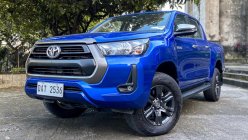In the 1980s, the Philippines was certainly a very different place. In Quezon City, Commonwealth Avenue’s sides were dominated by trees. Moreover, the roads leading in and out of the provinces were little more than bulldozed dirt pathways that were occasionally reinforced with a sprinkling of limestone.
With that said, majority of Filipinos needed tough vehicles to go about their day. At that time, there were of course the several examples of Asian Utility Vehicles (AUV). But then again, the Toyota Hilux entered the scene, and so we got a taste of the car that cemented itself as immortal.
Toyota Hilux 5th-gen: Crude but tough
Back in the 1980s, Toyota models were sold by Delta Motors Corporation. However, the said company shuttered down in 1988 and was then replaced by the Toyota Motor Philippines Corporation (TMPC). At that time, TMPC introduced the fifth-generation Hilux.
Toyota’s formal entry into the country via TMPC made the Hilux a household name. The fifth-gen model of Toyota’s midsize pickup truck is also the second longest running Hilux model. It was offered from 1988 to 1998.
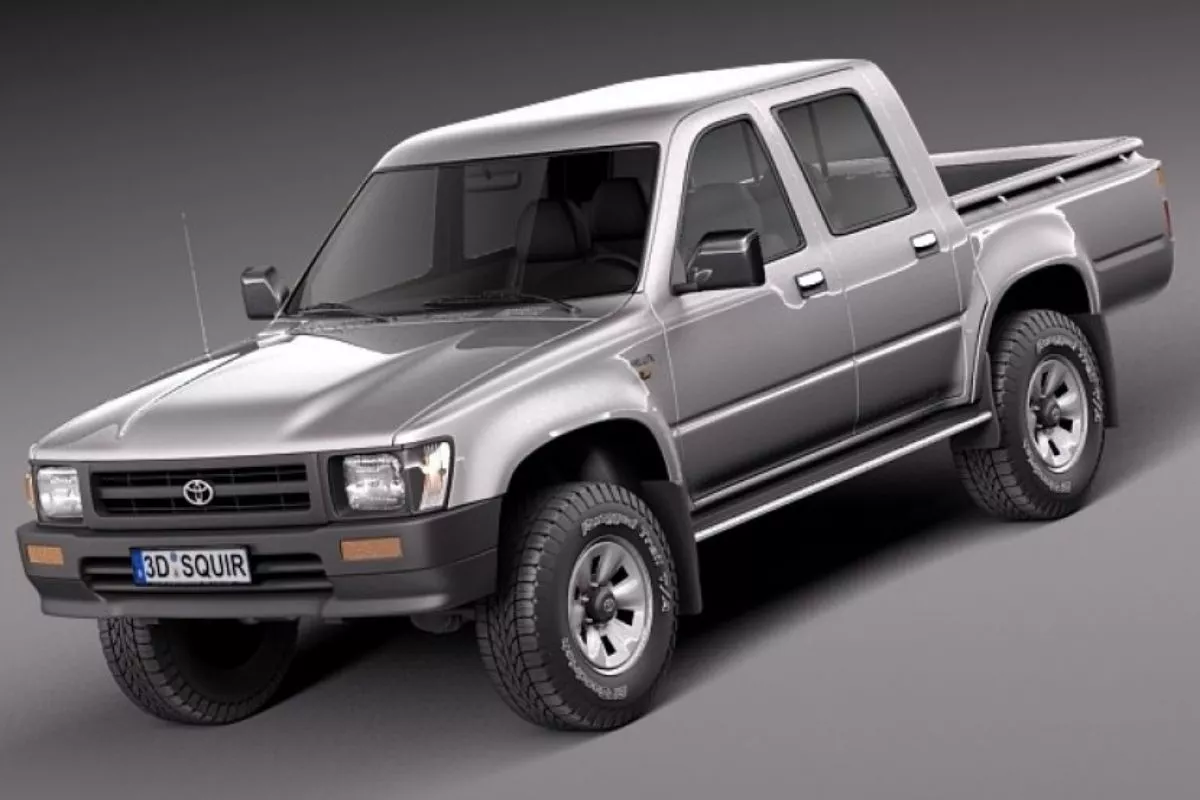
The 5th-gen Hilux looks boxy, and doesn't have much flair
>>> Related: 2021 Toyota Hilux Mako is an angry looking truck
So, what’s so special about the fifth-gen Toyota Hilux? Well, it wasn’t fast or sporty, but it was definitely a tough nut to crack. Current and previous owners of the truck also say that it was easy to maintain and fix.
This is of course, evident from the fact that the said model used the same diesel-sipping 2.4-liter 2L-II engine that powered the equally robust Toyota Tamaraw FX. The Toyota-made truck was also available in 4x4, and even from the factory, it had enough ground clearance to handle what the Philippine islands could throw at it.
The 2L-II engine was available throughout the fifth-gen Hilux’s lifetime, but it wasn’t that particularly strong output-wise. At the most, it can churn out up to 89 horsepower and 167 Nm of torque.
The said engine was paired to a five-speed, four-speed manual, or four-speed automatic depending on the variant and market. But then again, it was more than enough for what the Hilux was designed for, a workhorse vehicle.
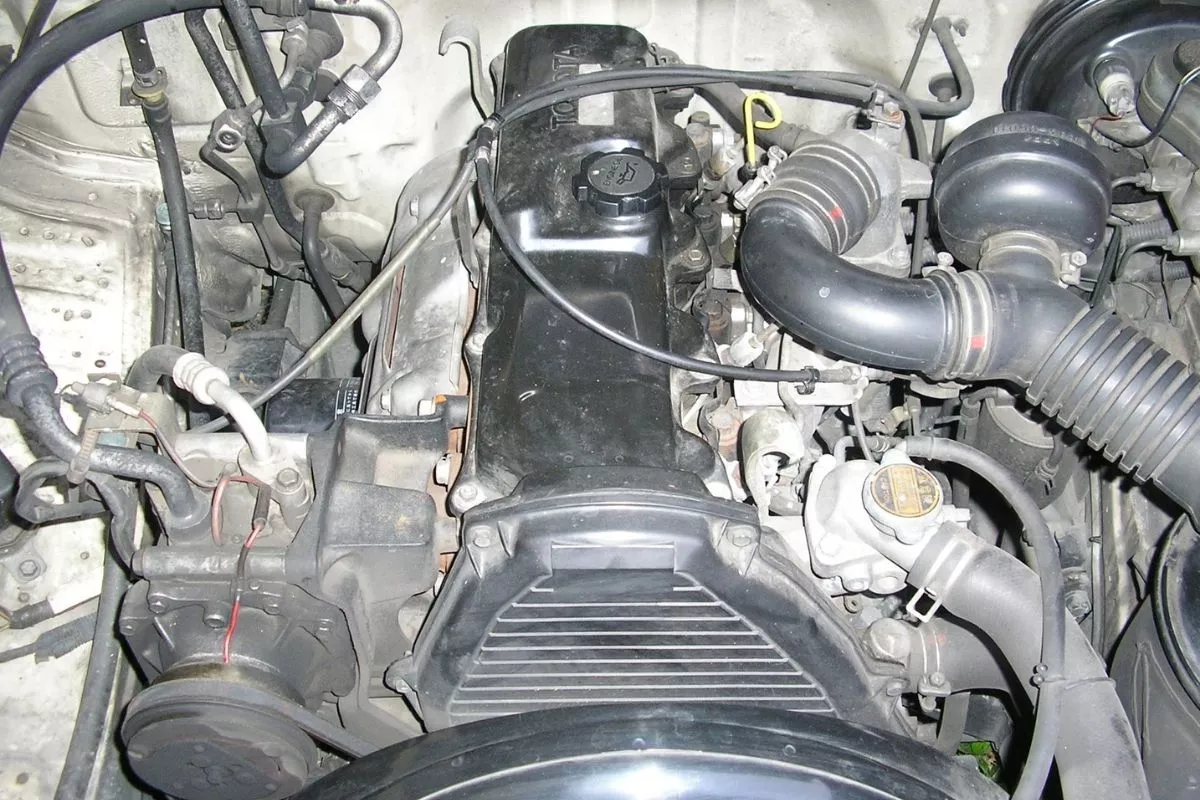
The 1988-1998 Hilux's 2L-series engine
here was also the 2.0-liter 3L engine, which made 90 horsepower and 188 Nm of torque, as well as a bunch of gasoline engines. In the United States, their version of the fifth-gen Hilux was propelled by the 3.0-liter V6 capable of making up to 150 horsepower.
Then there’s the world-famous 2.4-liter 22R-E inline-4 gasoline engine, which many Toyota-heads argue as the most reliable gasoline engine Toyota ever made. Like the diesel engines though, this engine could only make 113 horsepower and 192 Nm of torque. But yes, there are records that it could reach more than a million kilometers on its odometer.
The most important thing about the Hilux however, is its boxed body-on-frame chassis. Other ladder-on-frame trucks at the time used a C-frame, which is called as such due to having a “c” shaped cross-section. The Hilux instead uses a fully-boxed frame which doesn’t have an open-ended channel at all.
>>> Related: 2021 Toyota Hilux Old vs New: Spot the differences

The US-spec single-cab V6 variant
Sure, the C-channel type frames are cheaper to manufacture, more flexible, and lighter, but the fully boxed frame is just plain stronger. This is the key reason as to why the Hilux is so tough. Due to the aforementioned frame, it could be argued that the Hilux could carry heavier loads, on trickier terrain, for longer periods of time.
Today, the Hilux seventh-generation and the currently available eight-generation models are still using the boxed frame. This means that they have the tough credentials of their predecessors. In the US market however, Toyota replaced the fifth-gen Hilux with the larger Toyota Tacoma in 1997.
For the most part, the Hilux ended its stint in the US due to hefty import taxes, changing safety regulations, among others. The Tacoma and the Tundra also did away with the boxed frame chassis since the latter was found to be susceptible to rust.
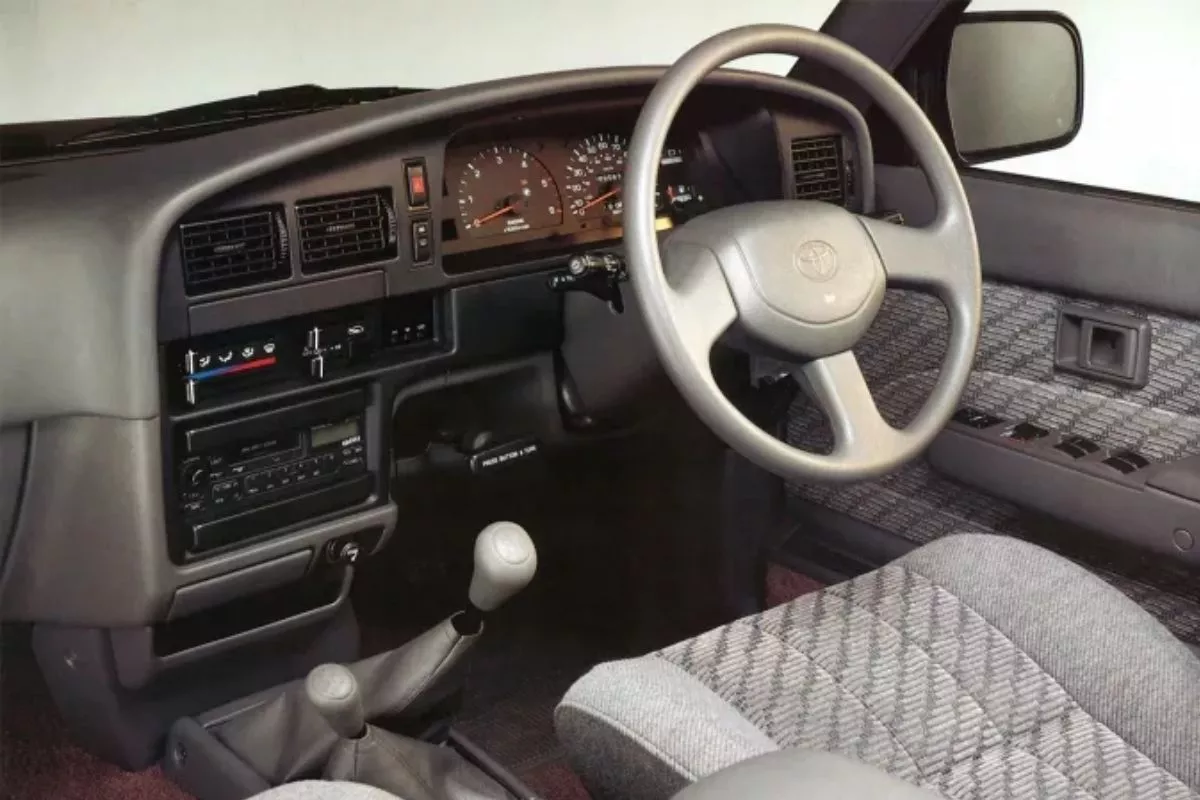
The interior of the 5th-gen Hilux. (Australia-spec shown)
As for the crude part, the interior of the fifth-gen Hilux didn’t have much to it. Most of its models didn’t have AC, and they didn't have any airbags. Its 4x4 system even used manual locking hubs, so you had to stop the truck, get out, and finagle with the hubs to engage 4x4. Again, it’s spartan, but it worked.
Toyota Hilux 5th-gen: You want one? Then read this
Being a work truck, surviving examples of the 5th-gen Hilux are mostly in rough shape aesthetically. Moreover, despite its strong chassis, even the Hilux’s mechanicals can suffer if abused. So, if you ever want to buy one, take note of the condition of its chassis and engine leaks.
Also, the 1988 to 1998 Hilux came under the radar of avid off-roaders due to its capability of taking the punishment from rough terrain. Off-roading is particularly stressful to any vehicle, even the Hilux.
If it wasn’t taken care of properly, it might have hidden mechanical problems that even the previous owner wasn’t aware of. As such, we advise that you bring a mechanic or another set of mechanically inclined eyes with you when checking out used Hilux units from this era.
>>> Related: 2021 Toyota Hilux gets 5-star safety rating from ASEAN NCAP
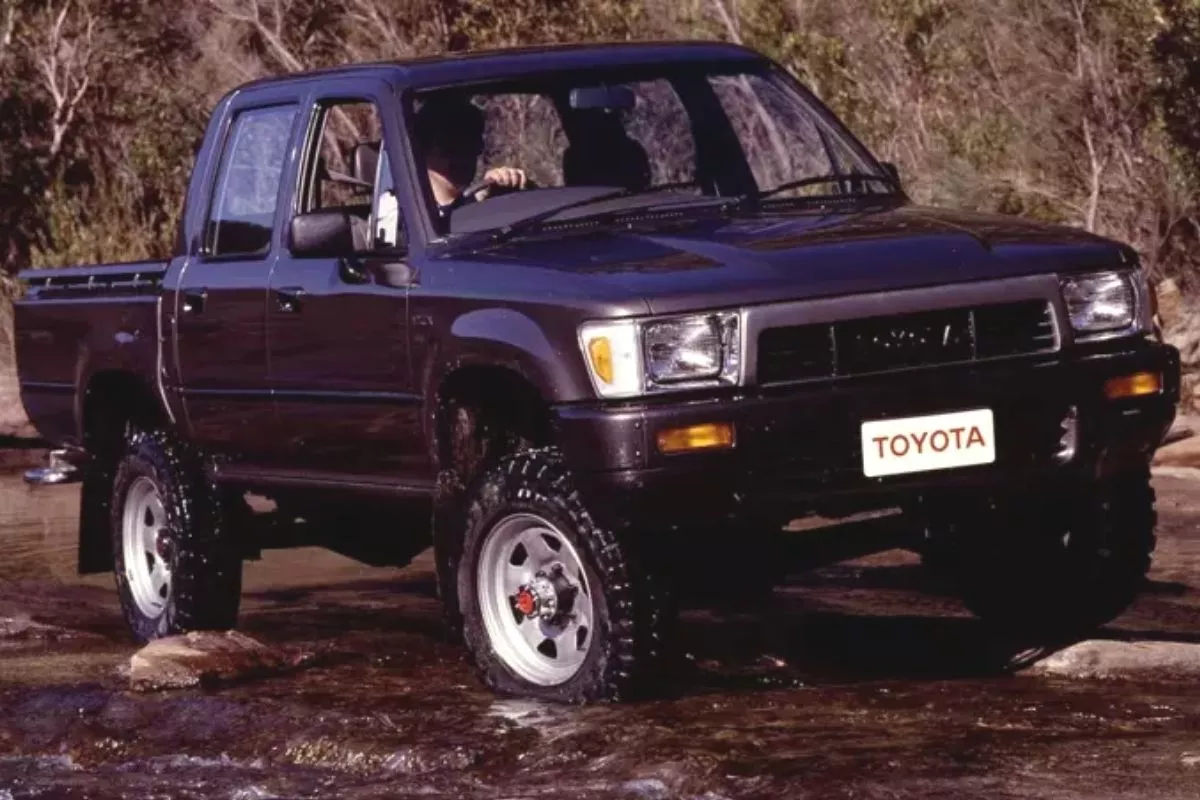
The 5th-generation Toyota Hilux going off-road
And lastly, watch out for haphazardly installed modifications as that might mean more trouble for you in the future. Overall though, the aftermarket support for older Hiluxes including the fifth-gen Hilux is still very much alive. And yes, there are countless mechanics operating nowadays who can fix the Hilux’s engine and transmission. They’re just that easy to repair.
You can view our car for sale section for the 1988-1998 Toyota Hilux and find one for yourself. For more nostalgic articles like this, keep reading here on Philkotse.com.
Know more about Toyota Hilux 2026

The Toyota Hilux 2025 is a midsize pickup offered in the local market as both fleet and regular units. Toyota Hilux Prices Philippines range from PHP 891,000 to PHP 2,198,000 with 13 variants, spanning from the basic cab & chassis 4x2 model to the range-topping GR Sport 4x4. It is also available in two turbodiesel engine options and four gearbox choices, accompanied by eight exterior colors. Dimensions start at 5,285mm in height, 1,800mm in width, and 1,700mm in height, with a wheelbase of 3,085mm. Among the rivals to the Toyota Hilux in the market are the Mitsubishi Strada, Nissan Navara, Ford Ranger, and the Isuzu D-Max.
This popular pickup continues to evolve and slowly move upmarket after gaining luxuries. The most significant revolutionary jump of the Hilux happened in 2004 when the seventh generation of the model was introduced. It was the first 21st-century iteration of Toyota's pickup. It is also the first generation to ride on Toyota’s new Innovative Multi-purpose Vehicle architecture. It provided improved safety, better ride comfort, modern D-4D diesel engines, more interior space, and a more modern aerodynamic body.
The current 8th generation offers a more refined and stylish design than its predecessor, but the tradition of being a tough pickup continues. It received a much-awaited refresh in 2020.
>>> New and used Toyota Hilux 2025 for sale in the Philippines
Toyota Hilux Launch
Toyota Motor Philippines (TMP) debuted the refreshed Toyota Hilux in 2020, featuring a meaner and more aggressive pickup truck design from the front to the back. The biggest update the Japanese carmaker added to the latest model is the minor power bump for the 2.8-liter engine option, which now makes it one of the most powerful in terms of performance numbers.
To cater to different car consumers who are in the automotive market for a reliable workhorse, TMP is offering its pickup truck with a wide array of variants, namely the Cab & Chassis, Cargo, J, FX, E, J, G, and the top-of-the-line Conquest. Only the top-ranging variant gets to benefit from the updated engine that now joins the superb 500 Club alongside the Ford Ranger
For 2025, the GR Sport received a massive update and it is now more powerful and more off-road capable than its predecessor. The brand also added a new E AT trim to its variant lineup.
Toyota Hilux Exterior
The current generation Toyota Hilux features a bolder and more rugged exterior styling. When Toyota's business unit in the Philippines introduced the Conquest variant of the Hilux, it received some much-needed flare. The top variants can turn heads because of their several external enhancements. The Conquest variant of the Hilux features a more aggressive exterior design while the standard variant leans on the safer side.
Upfront, it can come with either a set of projector or reflector halogen headlights, depending on the chosen variant. The higher trim levels feature an LED lighting set, as well as benefit from an array of DRLs. The E and G variants ride on 17-inch wheels, while the Conquest uses 18-inch gloss black alloy wheels. The new GR Sport meanwhile, also uses a 17-inch though these are off-road ready, Dakar-inspired wheels.

The current generation Toyota Hilux features a bolder exterior
Other exclusive features made available on the Toyota Hilux Conquest variants only include a tailgate assist, a bedliner, a sports bar, a roof ornament, and side decals to provide a sturdier road presence on the go.
The GR Sport meanwhile, gets a wider track width, a set of beefier fender flares, an aero sports bar, under chassis protection, etc.
Toyota Hilux Interior
The Toyota Hilux currently on sale mostly carries over the interior from the 2020 update. Inside the pickup, there is the right amount of dimensionality that is also found in other Toyota vehicles offered in the Philippines that sit on the same platform. However, there are subtler styling elements that distinctly mark it as Hilux.
Higher trim levels feature seats with leather wrappings while lower trims have fabric seat coverings. Top variants are also equipped with automatic climate control and steering wheel audio control that depends on the head unit. The twin-dial setup gauge cluster comes with a multi-function display in the middle.
Technology & Safety Features
For on-board entertainment, Toyota gave the G a new eight-inch touchscreen. The Conquest likewise uses an eight-inch display, while the updated GR-S comes with a nine-inch headunit. The E meanwhile, retains its 6.75-inch display. Standard on the Conquest and GR-Sport is wireless Android Auto, wireless Apple CarPlay, Bluetooth, and USB connectivity. The displays on the G though, get the wired version of Apple CarPlay and Android Auto.
The top-range variants come with a push-start system and keyless entry. Hill-start assist is also available in this pickup. It adds to the livability and drivability of the Toyota Hilux. Depending on the trim, the Hilux also gets radar cruise control.
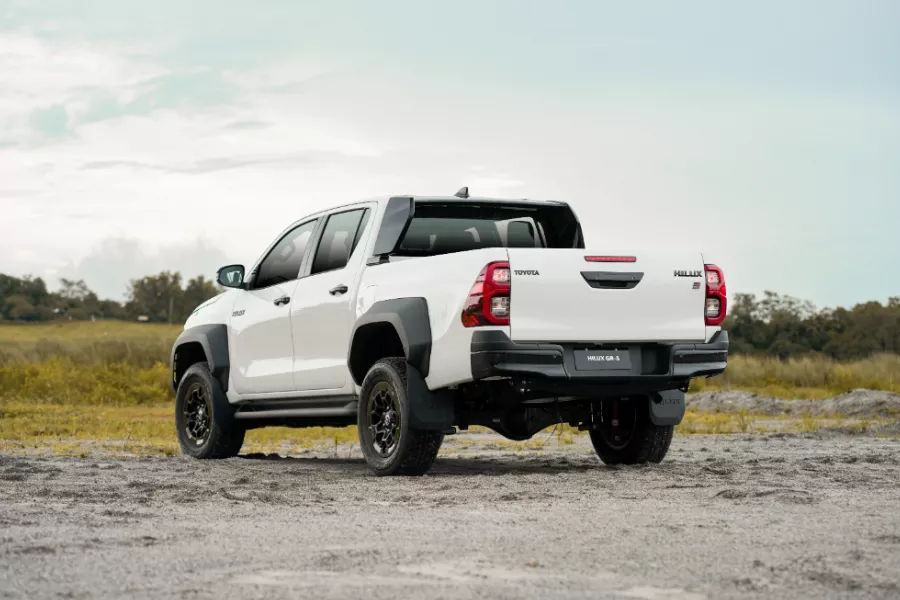
Safety is not an issue for the Toyota Hilux
This popular pickup from Toyota is a safe vehicle. The basic variant features passenger’s and driver’s airbags as standard. Higher variants have two front, side, and curtain airbags. Other safety features include ABS with EBD, brake assist, stability control, and speed-sensing door locks.
The GR-S and the Conquest get the Toyota Safety Sense driver-assistive kit, which includes a pre-collision system, lane departure alert, and more. The higher-spec trims also have blind-spot monitoring, rear cross-traffic alert, and a panoramic view parking camera.
Platform & Chassis
The Toyota Hilux is a midsize four-door pickup truck. It shares the same Toyota IMV platform as Innova and Fortuner. This pickup truck features a double-wishbone front suspension, and the rear setup is a rigid axle with leaf springs to further bolster its reputation as a reliable workhorse in the Philippines.
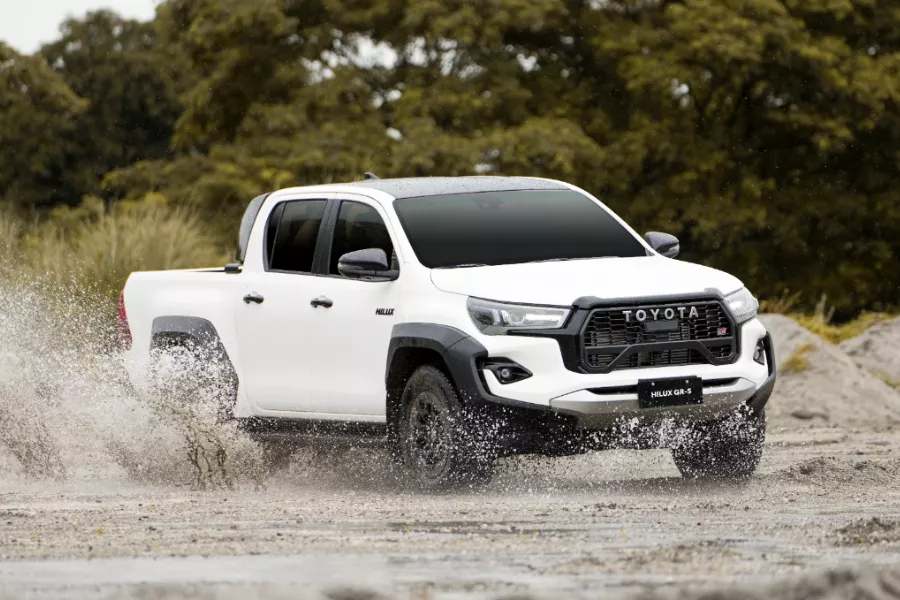
Toyota's pickup truck has a commanding presence on the road
On the top-spec GR Sport, the Hilux's suspension system is updated with monotube shock absorbers. It is also the only trim that gets disc brakes for all four wheels.
Engine & Drivetrain
Under the hood, TMP offers two engine options for its entry to the Philippine pickup truck segment. The first engine option is a 2.4-liter 2GD-FTV diesel engine which is used on the E, G, and Conquest 4x2 variants. It can generate 148 hp at 3,400 rpm and 400 Nm of torque at 1,600 to 2,000 rpm.
The second engine option for the model is a larger 2.8-liter 1GD-FTV turbo-diesel engine which is capable of generating 201 hp at 3,400 rpm and 420 Nm of torque at 1,400 to 3,400 rpm (500 Nm of torque for the top-of-the-line Conquest 4X4 A/T variant). Both the said engines can be paired to either a 6-speed manual or 6-speed automatic transmission, depending on the chosen variant.
The updated 2025 GR-Sport meanwhile, is propelled by a 2.8-liter turbodiesel that can generate up to 220 horsepower and 550 Nm of torque. Like the other automatic versions, it also uses a six-speed gearbox, but this has been tuned for better performance.
>>> Related posts:
- 2020 Ford Ranger vs Toyota Hilux Comparison: Spec Sheet Battle
- What comes with the Toyota Hilux 2020 Philippines? Take a glimpse at the updated Aus-spec version
Available colors for the Toyota Hilux Philippines are Super White, Silver Metallic, Gray Metallic, Attitude Black Mica, Crimson Spark Red Metallic, Nebula Blue Metallic, Orange Metallic, and Emotional Red.
Much like most of its rivals, the Toyota Hilux 2025 comes with a rear-locking differential for added traction and control in slippery driving conditions, especially when off-road. It also retains its 1,115-kilogram payload capacity, one of the highest in its segment, for superb carrying capability. Toyota has equipped the Hilux with a variable-flow control power steering pump to relieve driver stress during strenuous drives.
Toyota Hilux Pros & Cons
Pros
- Rugged appearance
- High payload capacity
- Improved steering
- Powerful engine choices
Cons
- Harsh ride
- No power tailgate function
- Top-spec variant is expensive compared to its rivals
Toyota Hilux 2025 Price List
| Variants | Price |
|---|---|
| Toyota Hilux 2.4 Cab & Chassis 4x2 MT | ₱891,000 |
| Toyota Hilux 2.4 J DSL 4x2 MT | ₱1,001,000 |
| Toyota Hilux 2.4 Cargo 4x2 MT | ₱1,007,000 |
| Toyota Hilux 2.4 FX 4x2 MT (w/ rear A/C) | ₱1,130,000 |
| Toyota Hilux 2.4 J DSL 4x4 MT | ₱1,201,000 |
| Toyota Hilux 2.4 E DSL 4x2 MT | ₱1,318,000 |
| Toyota Hilux 2.4 G DSL 4x2 MT | ₱1,396,000 |
| Toyota Hilux 2.4 E DSL 4x2 AT | ₱1,398,000 |
| Toyota Hilux 2.4 G DSL 4x2 AT | ₱1,472,000 |
| Toyota Hilux Conquest 2.4 DSL 4x2 AT | ₱1,681,000 |
| Toyota Hilux Conquest 2.4 DSL 4x2 AT (Emotional Red) | ₱1,701,000 |
| Toyota Hilux Conquest 2.8 DSL 4x4 MT | ₱2,009,000 |
| Toyota Hilux Conquest 2.8 DSL 4x4 MT (Emotional Red) | ₱2,029,000 |
| Toyota Hilux Conquest 2.8 DSL 4x4 AT | ₱2,084,000 |
| Toyota Hilux Conquest 2.8 DSL 4x4 AT (Emotional Red) | ₱2,104,000 |
| Toyota Hilux 2.8 GR Sport AT | ₱2,164,000 |
| Toyota Hilux 2.8 GR-S 4x4 AT | ₱2,178,000 |
| Toyota Hilux 2.8 GR Sport AT (Emotional Red) | ₱2,184,000 |
| Toyota Hilux 2.8 GR-S 4x4 AT (Emotional Red) | ₱2,384,000 |
Toyota Hilux FAQs
1. How much is the Toyota Hilux 2025 Philippines?
Toyota Hilux 2025 price Philippines ranges from 885,000 PHP for the entry-level 2.4 Cab & Chassis 4x2 MT to 2,192,000 PHP for the top-of-the-line Toyota Hilux GR Sport 2.8 4x4 AT (Emotional Red color).
2. What are the Dimensions of Hilux 2025?
Dimensions for the Toyota Hilux 2025 include 5,285mm in length, 1,800mm in width, and 1,700mm in height, with a wheelbase of 3,085mm.
3. What are the colors available in Hilux Philippines?
Toyota Hilux 2025 colors are available in 5 colors in the following shades: White, Super White, Sliver Metallic, Gray Metallic, Crimson Red, Attitude Black Mica, Nebula Blue Metallic, Orange Metallic, and Emotional Red.
4. What is the Engine Capacity of Hilux Conquest 2.4 4x2 MT?
Toyota Hilux Conquest 2.4 4x2 MT is offered with a 2.4-liter 2GD-FTV diesel engine which can generate 148 hp at 3,400 rpm and 400 Nm of torque at 1,600 to 2,000 rpm.
5. Is the Toyota Hilux available in Automatic Transmission?
Yes, it is. All Hilux trims available in the Philippines are automatic transmissions.
₱ 879,000 - ₱ 2,166,000
ExploreRecent posts
- toyota hilux at35 ranger raptor rival Feb 23, 2021
- Toyota Hilux Maintenance Guide Mar 04, 2021
- Toyota Hilux variants guide Jan 11, 2023
- How the Toyota Hilux has changed since 1968 Apr 01, 2021
- Why the Toyota Hilux is extremely popular among Filipino car buyers May 27, 2021






